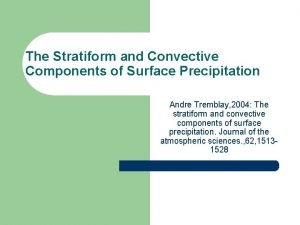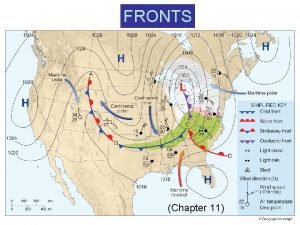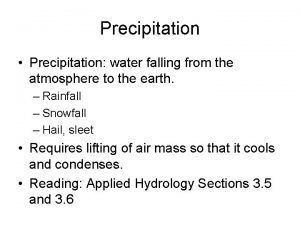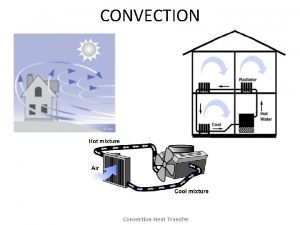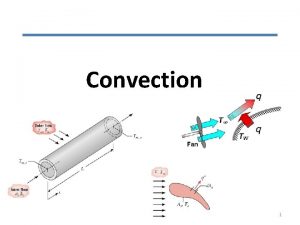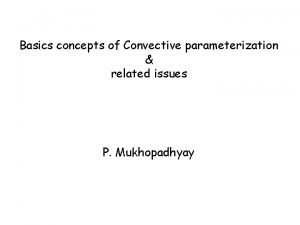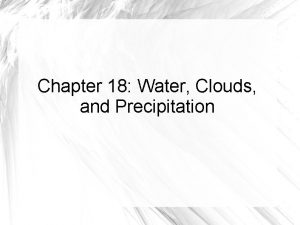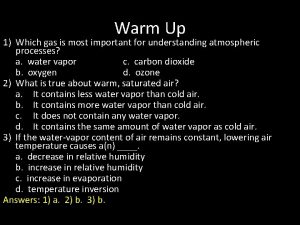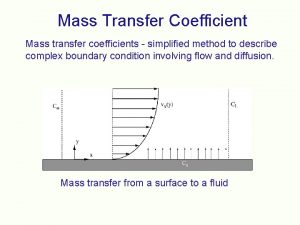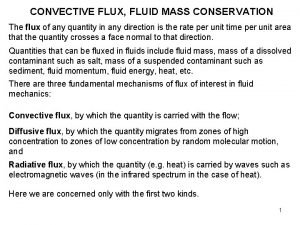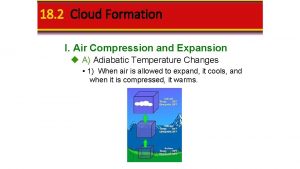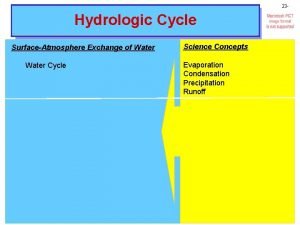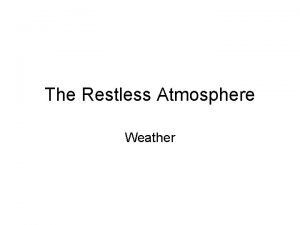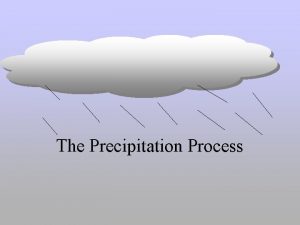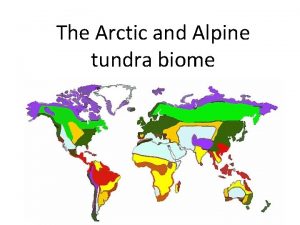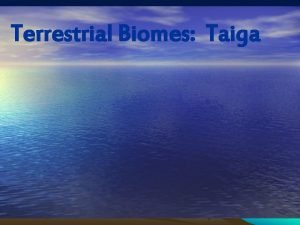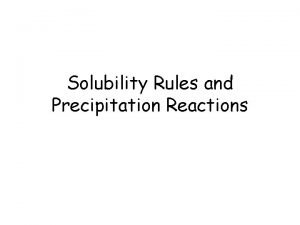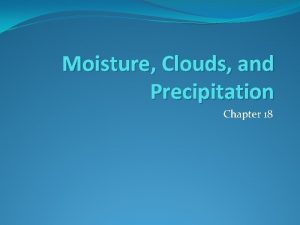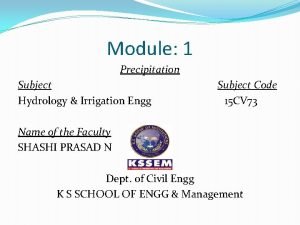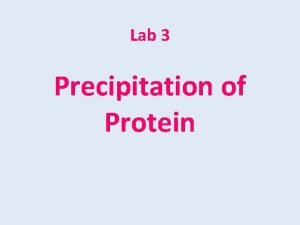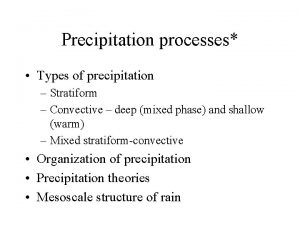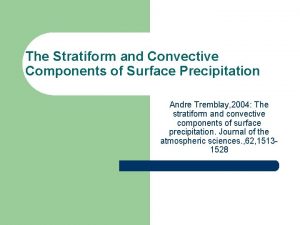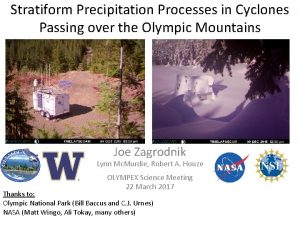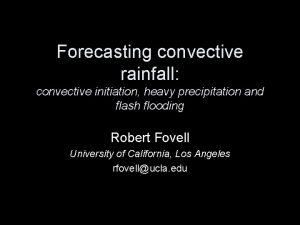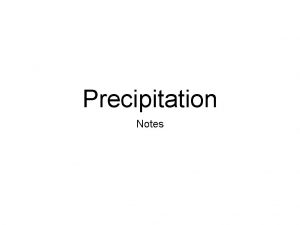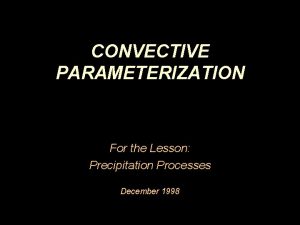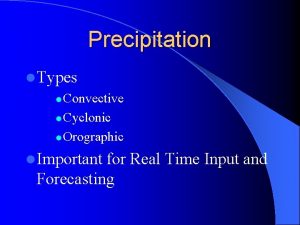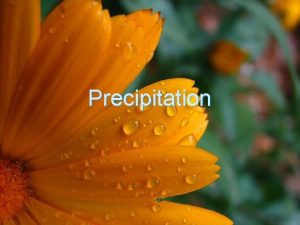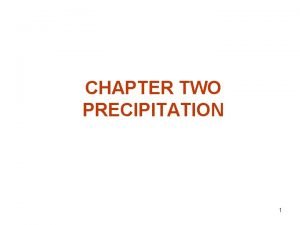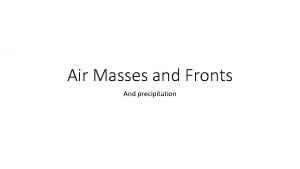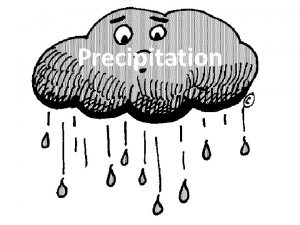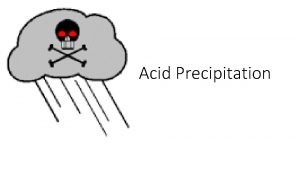Precipitation processes Types of precipitation Stratiform Convective deep













































- Slides: 45

Precipitation processes* • Types of precipitation – Stratiform – Convective – deep (mixed phase) and shallow (warm) – Mixed stratiform-convective • Organization of precipitation • Precipitation theories • Mesoscale structure of rain

Nimbostratus and stratiform precipitation • Classification of precipitation – stratiform: |w| < Vice, where Vice is in the range 1 -3 m s-1 • Vice refers to snow and aggregates – convective: |w| Vice • A more detailed classification (see following figure) – – shallow convection deep convection mixed convective/stratiform (pure) stratiform

Precipitation formation: simple flow chart Fig. 8. 10. Simplified schematic of the precipitation processes active in clouds. Taken from Lamb (2001). Compare with the complex diagram in thefollowing frame.

Precipitation formation: complex flow chart

A classification scheme based on vertically pointing radar data (Tokay et al 1999) bright band spectrum width Z > 10 d. BZ

Examples of automated precipitation classification scheme based on the preceding algorithm. From Tokay et al (1999, JAM).

From Tokay et al (1999, JAM).

From Tokay et al (1999, JAM).

A physical definition of convective vs. stratiform precipitation • Convective precipitation – hydrometeors move upwards at some point during the growth phase – growth time scale ~20 -30 min – Rain rate, R > 10 mm hr-1 • Stratiform precipitation – – hydrometeors fall during growth R typically 1 -5 mm hr-1 growth time scale 1 -2 h for a deep Ns system significant stratiform precipitation likely requires an ice phase • the exception is drizzle from Sc, but this is not significant

The importance of stratiform precipitation • For the Huntsville region, stratiform precipiation occurs ~99% of the time (large area) • A much greater fraction of rain originates from convective precipitation (40 -60%) – Some estimates: • • DJF - 90% stratiform and 10% convective MAM - 35% stratiform and 65% convective JJA - 20% stratiform and 80% convective SON - 35% stratiform and 65% convective

Types of precipitation: focus on stratiform Stratiform Large variations in the vertical, small in the horizontal Weak w, < 1 m s-1 (w < VT) Precipitation growth during the “fall” of a precipitation particle Convective Less substantial variations in the vertical, large in the horizontal Strong w, 5 -50 m s-1 Time dependence Evolution to stratiform

Conceptual picture of precipitation growth in (a) stratiform and (b) convective clouds Quasi-steady state process, function of height Fig. 6. 1 from Houze Time-dependent process, but also a function of height

Idealized stratiform cloud system 10 Ice crystals Height (km) 6 km 0. 4 km 0 0 2 4 6 8 10 Mean diameter (mm) Snow Aggregates Rain Melting layer: Water-coated or spongy ice Vertical variation of particle types within a nimbostratus stratiform cloud system

Melting within stratiform precipitation produces the radar bright band Ice crystals Growth of pristine ice by deposition Some growth by deposition, riming Primary growth by aggregation aggregates melting rain Change in Z due to various processes (Wexler 1955), p. 200 in R&Y Snow to bright band Bright band to rain Melting VT +6 -1 +1 -6 Shape +1. 5 -1. 5 Condensation 0 +0. 5 Total +6. 5 d. B -6 d. B

Idealized radar profiles around the 0 C level Growth by vapor deposition Deposition, riming (? ) and aggregation Aggregation + melting Conversion to raindrops, breakup of aggregates (? ) Some notes: Z for ice is lower than Z for snow of the same water content because of difference in dielectric constant. When all ice converts to raindrops, the particle concentration is reduced due to increase fall speeds.



Tropical Storm Gabrielle

0548 MIPS

1247 MIPS

Variability in the bright band (stratiform regions) SNR • 0548 UTC – thick – enhanced SW layer above – uniform VT 0 C • 1247 UTC – thin – greater SW below – decreasing VT 0 C W sv

Top panels: Reflectivity shows the bright band, Doppler velocity shows the increase in fall speed as snow/aggregates melt to form rain drops.

Hurricane Isaac

Measured profiles of ice hydrometeors Fig. 6. 3 from Houze. Ice particle concentration obtained from aircraft flights through nimbostratus in tropical MCSs over the Bay of Bengal.

Structure of a stratiform rainband, showing dynamical and microphysical processes. Fig. 6. 8 from Houze (1993)

Numerical simulation design of precipitation processes in frontal stratiform precipitation. Fig. 6. 9 from Houze

Results of a numerical simulation of precipitation processes in a frontal stratiform rainband. Each panel shows the rates of conversion for the process considered (10 -4 g kg-1 s-1)

Conceptual model of the development of nimbostratus associated with deep convection. Fig. 6. 11 from Houze Fig. 6. 10 Houze

Schematic of the precipitation mechanisms in a MCS. Solid arrows are hydrometeor trajectories. From Fig. 6. 13 of Houze

Stratiform/convective clouds associated with midlatitude cyclones and fronts

Examples of a four different narrow cold frontal rainbands. The location of the cold front is shown. Note the different orientation of the smaller elements within the rainband. Fig. 11. 28 of Houze

Hypothesized airflow along a cold frontal rainband, and the development of wave features due to horizontal shearing instability. (Fig. 11. 30 of Houze). Schematic of the relative airflow across two precipitation cores, and the gap between them, in a narrow cold frontal rainband. The airflow, represented as wind vectors, was inferred from Doppler radar. Fig. 11. 29 from Houze.

Cloud structure, air motions, and precipitation mechanisms within cold frontal bands. This structure is derived from aircraft, Doppler radar, and other sources. Fig. 11. 31 of Houze.

Schematic of clouds, precipitation, and thermal field of a warm frontal rainband as deduced from rawinsonde, aircraft and radar data. The region above the elevated warm front is convectively unstable (qe decreases with height). Fig. 11. 38 of Houze.

UAH/NSSTC ARMOR 10/27/2006: 3 -D View of light, stratiform Rain Rate Plan view 12 5 k m Profile of liquid dependent on ice process/types Vertical Cross-Section 300 o Polarimetric Hydrometeor ID Radar Reflectivity Height (km) 10 5 0 Dry Snow Light. Rain Irreg. Ice Wet Snow Drizzle Horiz. -oriented ice Melting Layer Proprietary information, Walter A. Petersen, University of Alabama Huntsville

ARMOR: 27 October 2006 Bright band variability and precipitation (RHI’s over MIPS wind profiler every 2 -3 minutes) +/- 500 m oscillations in melting level height, and finally a rise with warm front! DSD properties from combined profiler/radar retrieval

ARMOR: 10 January 2011 – Tennessee Valley Thundersnow

ARMOR: 10 January 2011 – Tennessee Valley Thundersnow

Stratiform precipitation within a midlatitude cyclone Small ice crystals Snow (1 -2 mm) large aggregates (5 -10 mm) large raindrops (2 -3 mm) bright band small raindrops (1 -2 mm) time Reflectivity factor measured by a vertically pointing X-band radar Stratiform precipitation with both ice and water phase is common over large regions in both the tropics (mesoscale convective systems and tropical storms) and midlatitudes (within low pressure regions) The bright band region could be especially problematic.

Vertical air motion is required for precipitation production

Schematic cross section of a wide cold frontal rainband. From Hobbs et al 1980.

Vertically pointing Doppler radar measurements within a stratiform rain band Reflectivity factor: Bright band Rain streaks Doppler velocity Fall speeds for snow vs. fall speeds for rain Spectrum width Low in snow (not much variation in fall speeds), high in rain (greater variation in fall speeds)

Reflectivity Generating Cells Radial Velocity (vertical) Spectrum Width Dry Slot

Reflectivity Generating Cells Radial Velocity (vertical)

Precipitation Paths: Possible scenarios Precipitation 1. Stratiform rain system with bright band large aggregates near the bright band (relatively common) 2. Shallow convective cloud, small drops (0. 5 mm diameter) 3. Shallow convective cloud, large drops (e. g. , the Hawaiian shallow clouds that develop raindrops to diameters of 5 -8 mm; Rauber et al 1991). 4. Deep convective cloud with graupel, snow, aggregates, and rain 5. Item (4), with the addition of hail Clouds without large precipitation a) Stratocumulus clouds, between 0. 2 and 0. 8 km above sea level (ASL), with 0. 2 mm drizzle droplets (common) b) Cirrus clouds, between 8 and 12 km ASL, with ice crystals up to 1 mm in diameter (common)
 Stratiform rain
Stratiform rain Stratiform clouds
Stratiform clouds Clouds fog or dew will always form when
Clouds fog or dew will always form when Gravimetry steps
Gravimetry steps Co precipitation and post precipitation
Co precipitation and post precipitation Concurrent in os
Concurrent in os Deep asleep deep asleep it lies
Deep asleep deep asleep it lies Deep forest: towards an alternative to deep neural networks
Deep forest: towards an alternative to deep neural networks O the deep deep love of jesus
O the deep deep love of jesus Convective rain
Convective rain Convective sigmet
Convective sigmet Convective clouds
Convective clouds Nusselt number laminar flow in tube
Nusselt number laminar flow in tube Convection heat transfer formula
Convection heat transfer formula Introduction to convection
Introduction to convection Convective parameterization
Convective parameterization Love of cloud and rain chapter 18
Love of cloud and rain chapter 18 Frontal wedging definition
Frontal wedging definition Orographic lifting
Orographic lifting Mass transport
Mass transport Flux of fluid
Flux of fluid Localized convective lifting
Localized convective lifting Types of precipitation
Types of precipitation Types of precipitation
Types of precipitation 10 types of morphological processes
10 types of morphological processes Ammonium sulfate precipitation
Ammonium sulfate precipitation Transpiration
Transpiration Tundra biome project
Tundra biome project Taiga biome temperature
Taiga biome temperature Convectional rainfall diagram
Convectional rainfall diagram It is a form of solid precipitation
It is a form of solid precipitation Lacemops stand for
Lacemops stand for Chaparral biome precipitation
Chaparral biome precipitation Where is the tundra located
Where is the tundra located Location in taiga
Location in taiga Deciduous forest climate
Deciduous forest climate Temperate deciduous forest animal adaptations
Temperate deciduous forest animal adaptations Precipitation solubility rules
Precipitation solubility rules What is precipitation?
What is precipitation? Precipitation word equation
Precipitation word equation Ascoli's thermo precipitation test
Ascoli's thermo precipitation test Chapter 18 moisture clouds and precipitation answer key
Chapter 18 moisture clouds and precipitation answer key Rainguages
Rainguages Lesson 90 solid evidence precipitation reactions
Lesson 90 solid evidence precipitation reactions How precipitation forms
How precipitation forms Precipitation of proteins by strong mineral acids
Precipitation of proteins by strong mineral acids
